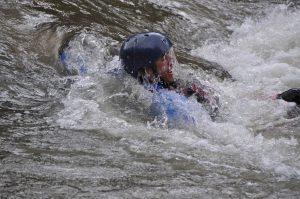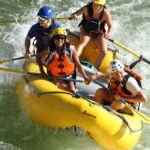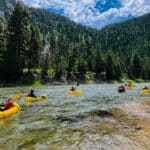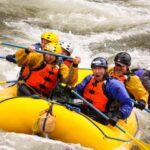Surviving A Whitewater Swim
You are on a spring whitewater rafting trip, paddling hard, when the raft hits a huge wave and the “unsinkable” happens; you are swimming unintentionally in the middle of a rapid. Swimming is not really the right word for is happening at first, it’s more like the rapid is chewing on you, swishing you around, and enveloping you in liquid power. Now’s a good time to remind yourself that this is an adventure. A little preparation and good technique can go a long way towards minimizing risk and even making it fun.
Wear A Lifejacket
You are wearing a lifejacket. That’s a good thing because if you weren’t, chances of survival go down considerably. If there is one thing that identifies ignorance and inexperience on a whitewater river, it’s someone not wearing a lifejacket. Don’t run the river with someone who doesn’t require you to wear a lifejacket. Wear it, buckle every buckle and snug it down so it doesn’t ride up over your chin when you pull up on the shoulders. If it’s too loose the shoulders of the jacket will be floating high, but your face will be down in the water where it’s tough to breath. During a swim it’s worth taking a second to yank it down and retighten it.
Dress Properly
Inexperienced boaters underestimate how quickly cold water can incapacitate an unprotected swimmer. Sudden immersion in ice-cold water can take breath away, seize muscles and make self-rescue a challenge. Being dressed right is the first step towards survival. In cold whitewater conditions wear a helmet to protect your head and some good footwear, like neoprene booties or tennis shoes to protect your feet. A wetsuit or drysuit helps prevent hypothermia from a long swim. Many rafting companies provide a 3mm farmer john or jane wetsuit. Combine this sleeveless wetsuit with one or two top layers of fleece and a dry top or splash jacket. Wear snug fitting, non-cotton layers which provide warmth and absorb less water weight than loose layers when soaked. A life jacket with a whistle and a river knife goes on top. Neoprene gloves will keep your hands functioning and offer protection from impact on rocks.
Don’t Panic
When you fall in whitewater, it’s common to be held underwater for a few seconds. Time seems to slow down. It’s sort of like the dog years ratio, one actual second of submersion seems like about seven seconds. When you need to breath and can’t, three seconds can seem like twenty. This isn’t a long time at your desk, but can feel like forever at the bottom of a rapid. Don’t panic.
Whitewater is white because it’s turbulent and aerated. It’s common to swallow some of this froth and water during a swim. Don’t panic. In big waves it’s sometimes easiest to catch a breath in the trough or low point of the wave instead of the top of the wave where it’s breaking.
It’s common to end up directly underneath the boat. If that happens just put your hands over your head, feel the boat, and start moving one direction until you pop up beside it.
Use arm strokes to position yourself properly. Get feet up to minimize the risk of foot entrapment. Position feet downstream, toes at the surface and use your heels as radar to feel for and push off rocks. Be careful when you sit up to see what’s coming because you maybe lowering your feet our tailbone too much. Lay flat and arch your back to protect your tailbone in shallow water. Keep your feet pointed downstream and use your arms to angle your body to the current and backstroke to maneuver right or left. Keep your body long and streamlined to maneuver smoothly and efficiently. Good defensive swim technique minimizes your risk of getting unlucky once you are already in the water. The goal is to not get hurt and conserve energy to self rescue.
Find the boat. Reach it with your hand or by extending your paddle t-grip if you have one. Be careful anytime you are swimming downstream of a boat, be ready to aggressively swim out of the way so you don’t get pinched between a heavy boat and a rock or the edge of the river. If you are upstream of the boat sometimes it’s best just to go with the flow and catch up to it.
Feet Up! Minimize Risk of Entrapment
Everyone should know about the potential for entrapment in moving water. We minimize the risk of foot entrapment in moving water by keeping our feet up. It’s also important to be aware of other entrapment hazards on the river we are floating. Sieves in boulder gardens present the potential for entrapment. It’s nice to know where those are and have a pre-plan on how to avoid them in case of a swim. The number one entrapment hazard on Montana rivers are strainers. These can be trees along the bank that have fallen into current, log jams, debris piles, or anything that river current flows through that a person won’t. Until you have been pinned by a moderate three mile an hour current on a strainer and struggle and fail to self rescue, it’s hard to appreciate how deceptively powerful and relentless river current is. Always aggressively swim to avoid strainers. Ideally know ahead of time where they are and don’t ever end up in the river near upstream of one. If you are getting swept into one and can’t avoid it, turn over on your stomach, face downstream and swim aggressively toward it and try to climb up and on top of it.
Knowledge is Power
Know the type of river you are on and respect the fact that a Class III swim is worlds apart from a Class V swim. In a Class III swim you can really manage the risk and reduce the chance of injury by doing the things we are talking about. In a Class V swim you are going to have to get pretty lucky to not get banged up even if you are doing everything right.
Good guides give paddle crews additional information on specific rapids as they navigate the river. For example above difficult rapids, review defensive swimming, describe specific hazards to avoid, and discuss self- rescue options. Are there any dangerous features downstream to aggressively avoid? If there are sticky holes, know where they are, what shape they’re in at the current flow and what the best self-rescue options are.
In general a lower volume river or steeper gradient river will present a higher risk of foot entrapment or trauma from bumping into rocks– so good defensive swim technique is paramount. Keep those feet up, arch your back a little so your tailbone is not your lowest point. Be especially careful going over pour overs or holes where the river seems to try to suck your feet down.
In higher volume rivers be prepared to spend some time underwater in powerful eddy lines or big breaking waves. Concentrate on not panicking, and catch breaths in the trough of waves. It’s normal to swallow some water and cough or choke. Be patient. Don’t over exert yourself or try to fight the power of the river. If you’re dressed right, you have some time. In both cases, knowing the back-up plan is essential.
It’s safer and often essential to have a second boat or even a chase boat along as part of the back-up plan to assist swimmers. If you take a longer swim and need to self rescue by aggressively swimming to shore, watch out for strainers and do not try to stand up until you fingers are scraping the river bottom. Many people forget to emphasize that on single boat trips, the back-up plan is always self rescue. It’s good risk management to apply the buddy system to river trips, so you can have a lead and a sweep, or upstream and downstream safety at all times during a river trip.
Having said all of this, one of the best things you can do to defensive swim successfully, is to practice. Start in smaller hazard free class II and III rapids under the supervision of experienced boaters or guides. A good Swiftwater Rescue clinic will teach you how to read water, recognize and avoid hazards and give you plenty of opportunity to practice defensive and aggressive swimming in whitewater. Go to www.whitewater rescue.com for more info.
A quick review for surviving a whitewater swim:
Equipment: Use good equipment. Dress for a swim: a high quality, properly fitted life jacket, helmet, good protective footwear, and in cool conditions, proper thermal protection such as a wetsuit or drysuit.
Technique: Don’t panic and use good defensive swim technique to conserve your energy and avoid entrapment. Be prepared to self rescue.
Manage Risk: Prepare for the Unexpected. Use the Buddy system. Go with skilled and knowledgable paddlers. Carry first aid, extra gear and extra warmth. Have an emergency pre-plan in case something goes wrong–know what your communications options are.
See you on the river!






this is such a nice and useful information for us…i appreciate urs word……..Boat Rentals In Miami
Rishikesh Wonderful Place For Rafting. Gee Adventure Give affordable price and Best Services to you. Now call on this number +91 999 789 8002 or visit the online website http://www.adventurerafting.in
Rishikesh Beach Camping
My favorite part of your article is when you also gave tips if in case you fall in the water and your guide was not able to grab you out of the water. Luckily, floating on my back and positioning myself wherein the feet must go first to help me navigate is also what I have in mind if ever I am in that situation. What you said about the defensive swim position was really interesting to me.
Regarding “don’t panic” – I wonder if we could expand on that a little bit more on the how-to of it all (and probably rephrase it as: “relax”).
I just did a freediving course and a key thing was learning to be completely relaxed in the water, even if you’re 20m (well, or 50m) below the surface.
It’s crazy how big the difference is between being relaxed and not. I’m a beginner and I can spend 1 minute underwater if I’m truly relaxed (and not moving much).
You’d probably need to be a pretty dedicated whitewater rafter to do a freediving course just for safer rafting, but it’s an option. There was a surfer in my course who did it just for surfing (to be safe/relaxed when a wave pulls you underwater and until you resurface).